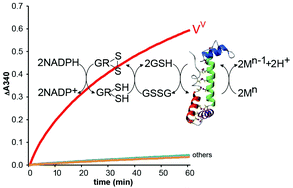Metal ion selectivity of the vanadium(v)-reductase Vanabin2
Abstract
In a previous study, Vanabin2, a member of a family of V(IV)-binding

- This article is part of the themed collection: Vanadium in Inorganic Chemistry
* Corresponding authors
a
Molecular Physiology Laboratory, Department of Biological Science, Graduate School of Science, Hiroshima University, 1-3-1 Kagamiyama, Higashi-Hiroshima 739-8526, Japan
E-mail:
ueki@hiroshima-u.ac.jp
Fax: +81-82-424-7437
Tel: +81-82-424-7437
In a previous study, Vanabin2, a member of a family of V(IV)-binding

 Please wait while we load your content...
Something went wrong. Try again?
Please wait while we load your content...
Something went wrong. Try again?
H. Kitayama, S. Yamamoto, H. Michibata and T. Ueki, Dalton Trans., 2013, 42, 11921 DOI: 10.1039/C3DT50404B
To request permission to reproduce material from this article, please go to the Copyright Clearance Center request page.
If you are an author contributing to an RSC publication, you do not need to request permission provided correct acknowledgement is given.
If you are the author of this article, you do not need to request permission to reproduce figures and diagrams provided correct acknowledgement is given. If you want to reproduce the whole article in a third-party publication (excluding your thesis/dissertation for which permission is not required) please go to the Copyright Clearance Center request page.
Read more about how to correctly acknowledge RSC content.
 Fetching data from CrossRef.
Fetching data from CrossRef.
This may take some time to load.
Loading related content
